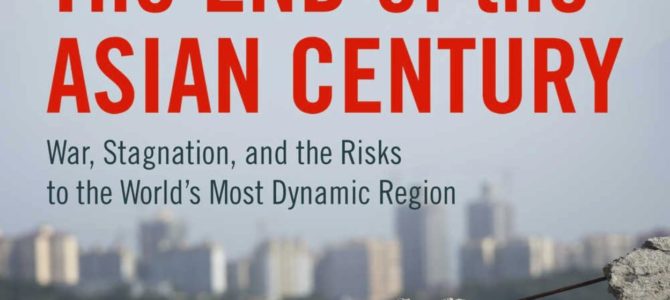
Threats posed by an ascendant Asia increasingly shape policy conversations in Washington and across the country. Why have American manufacturing jobs been declining? They’re moving to Asia. What’s wrong with America’s trade policies? China cheats. What keeps American officials up at night? It’s nuclear North Korea.
Some fears are misplaced. For instance, automation has a lot more to do with manufacturing job loss than cheap foreign labor. But Americans today have every reason to think that the nations of the Indo-Pacific are eating our lunch in a variety of ways. With plans like the Belt and Road Initiative and Made in China 2025, the initiative, energy, and potential of our far away, supposed rivals seem limitless. But is the world’s future inevitably an Asian one?
The answer may be more complicated than you think. In “The End of the Asian Century: War, Stagnation, and the Risks to the World’s Most Dynamic Region,” now available in paperback from the Yale University Press, Michael Auslin of the Hoover Institution makes the provocative case to the contrary. Rather than focusing solely on accommodating and competing with a rising Asia, Auslin makes the case that leaders’ attention should be on how the problems of the world’s most dynamic region threaten its rise and, in an interconnected world, the stability and prosperity its own people, neighbors, partners, and even rivals.
Auslin doesn’t predict that excitement and fear about the supposedly inevitable growth of the Indo-Pacific, and China in particular, are wrong. The amazing new cities, burgeoning middle classes, and impressive innovations are all there. But he does caution that we may be ignoring serious risk factors just below the surface, and, if those come to the fore, we shouldn’t be surprised.
The Goldilocks Dilemma
What are those growing risk factors? Auslin identifies the failure of economic reforms, demographic imbalances, fragile political systems, a lack of regional political community, and the threat of war between and among states.
The reader is taken on a tour of a “risk map” of Asia, through which each of these issues is examined. The areas overlap to a significant extent, but, while the themes are the same across borders, the specifics are different from country to country.
Auslin’s section on demographic imbalances most clearly demonstrates the common nature but different manifestations of risk. Using three case studies — Japan, China, and India — he reveals that most countries in the Indo-Pacific suffer from a “Goldilocks dilemma.” Each of them either has too many people or too few.
Japan’s birthrate fell below replacement level for the first time in the 1950s, rose briefly after that, and dropped again, never to recover, in the early 1970s. Demographic trends take a long time to manifest, but, in 2004, the population of Japan shrank for the first time. Today, Japan’s populations shrinks by hundreds of thousands every year. At this rate, there will be 30 percent fewer Japanese by 2060. Not only are there fewer Japanese today than there were yesterday, more than 25 percent of Japan’s population is over 65 years old.
Across the sea, China has had the worst of both worlds. Due to the infamous one-child policy, imposed in 1979, the world’s most populous country will soon also start facing demographic decline. The policy was meant to control overpopulation at a time when China was just beginning to develop a market economy, but has led to labor shortages, the aging of the population, and badly skewed sex ratio that has left Chinese men outnumbering women by 34 million. It’s unclear if the recent easing of restrictions on pregnancies will be able to reverse these trends.
Meanwhile, India’s most recent census showed an astonishing gain of 180 million persons, over half the population of the United States, in just one decade. Its population is projected to pass China’s by 2022, then making the world’s largest democracy also the world’s most populous country. This demographic boom is shared throughout much of south and southeast Asia.
A Careful Corrective
Each of these trends presents different challenges. Older populations demand more medical and social services from their governments. However, in many of these countries with older populations, there are too few laborers either to pay for or to provide those services. On the other side of the Goldilocks dilemma, young people need jobs, education, and strong infrastructure. If their economies can’t provide them in sufficient numbers for a growing population, then there will be unrest.
Other specific risks include everything from a dramatically slowing Chinese economy; to corruption and rising authoritarianism; to hot and cold border disputes on the Korean peninsula, across the Strait of Taiwan, on the Indian subcontinent, and on the seas up and down the eastern coast of the continent.
Challenges of these types would seriously shake developed, wealthy nations, and are even more pressing for the developing world.
One drawback to Auslin’s broad approach is that, by applying five different lenses to a huge continent with the largest and most diverse population of any part of the world, subjects that merit a whole chapter are maybe given just one or two sentences, leaving the reader wanting more than 50 pages of footnotes.
For example, when describing China’s unprecedented peacetime military buildup, Auslin cites official statistics from Beijing putting total Chinese defense spending at $145 billion in 2015. He then states that, “By some estimates, a more accurate exchange rate comparison reveals that it spends the equivalent $500 billion annually on its military, more than three-quarters of the US [defense] budget.” If China is indeed spending half a trillion dollars a year on its military, then that deserves more treatment. Perhaps even a whole book.
Auslin’s book is a careful corrective to blind faith in the rise of Asia and a reminder that nothing is inevitable. If he’s right, then the Asia hanging in the back of our minds may be more of a phantasm than a reality, and leaders and policy planners need to adjust their thinking accordingly.









